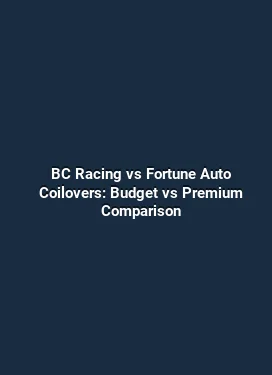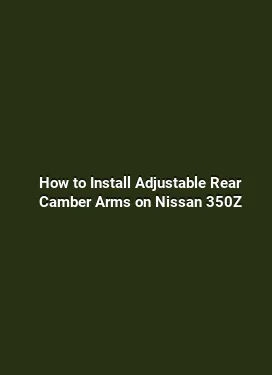How to Install a Roll Cage in a Street Car with Removable Door Bars
Installing a roll cage in a street car is a project that balances safety, performance, and practicality. When the vehicle remains street-legal, removable door bars offer a compromise that preserves accessibility, comfort, and everyday usability while still delivering the structural rigidity and rollover protection that track enthusiasts expect. This guide provides a detailed, real-world approach to selecting, fitting, and integrating a roll cage with removable door bars into a street-ready car. It covers material selection, fitment strategies, mounting hardware, and the interplay between the cage, suspension, and handling characteristics. Emphasis is placed on correct measurement, precise fabrication, and methodical testing to ensure that the final setup is robust, safe, and capable of handling routine street driving as well as occasional performance outings.
Foundations: Understanding Roll Cage Design and Placement

Structural goals and integration with street use

A roll cage for a street car must strike a balance between protection, weight, and practicality. The primary purpose is to maintain occupant safety in the event of a rollover or severe collision, but a well-designed cage also contributes to chassis stiffness, which can influence handling, steering feel, and suspension performance. Removable door bars are an important feature for street cars, allowing easier ingress and egress and preserving factory door structure when not needed. When selecting a cage, consider the following structural goals: ensuring rigid door openings for safer egress, maintaining a clear line of sight, and preserving airbag compatibility if the vehicle is equipped with modern restraint systems. The cage should be designed to minimize intrusion into the passenger compartment while maximizing protection in critical zones, especially around the A-pillar, rocker, and roof rail areas. Compatibility with existing safety systems, such as side-impact protection and seat mounting arrangements, should be evaluated early in the planning process.
The placement of uprights, main hoops, and door bar connections should align with the structural cores of the vehicle. Drilling or welding near high-load areas requires careful attention to material grade, heat-affected zones, and potential weakening of adjacent components. In street-oriented builds, the goal is to achieve sufficient torsional rigidity without introducing excessive weight or compromising interior space. Removable door bars typically attach via quick-release pins or locking bolts to clevis mounts integrated into the door jamb or rocker panel area. The design should allow quick removal without sacrificing lateral support during high-speed cornering or braking. When possible, consult the vehicle’s chassis data and sensor locations to avoid interference with airbags, crash sensors, and side curtain systems.
Materials, manufacturing tolerances, and weight considerations
Roll cages are commonly manufactured from mild steel, chromoly steel, or high-strength stainless variants. Each material presents trade-offs in terms of strength-to-weight ratio, weldability, and corrosion resistance. Mild steel cages are heavier but easier to weld in a range of shop environments, making them a practical choice for some street builds. Chromoly (often 4130 or 4140 alloys) cages offer higher strength with reduced weight, but they require skilled fabrication and precise welding to prevent heat-affected zone issues. Stainless options provide excellent corrosion resistance but can be more challenging to weld and align. For a street car with removable door bars, precise tolerances matter: mistimed welds or misaligned joints can compromise the intended safety performance and tighten up door clearance, making ingress and egress less comfortable.
Weight distribution around the cabin and roofline affects handling. A cage adds weight, which can influence unsprung and sprung mass interactions. Strategically locating main hoops and braces around existing structure can help minimize weight penalties while maximizing rigidity. In addition, proper door bar length and curvature ensures that the door bars do not interfere with seats, window regulators, or interior trim. A well-executed design accounts for both dynamic loads during aggressive driving and static loads from everyday use, providing predictable behavior under diverse conditions.
Planning the Installation: Measurements, Fitment, and Legal Boundaries
Precise measurements and workspace setup
Before any fabrication begins, take a thorough set of measurements from the vehicle, including door opening widths, roof height, A-pillar geometry, door jamb thickness, floor pan strength, and rocker panel clearance. A clean, stable workspace with ample lighting is essential. Mark reference points on the car’s exterior and interior to guide tube routing and brace placement. It’s prudent to create a digital or paper mock-up of the roll cage using straight and curved tube segments to visualize how the bars will align with seats, airbags, and dashboard components. This planning minimizes surprises during actual fabrication and helps optimize door-bar clearance when the bars are in the removable state.
Legal considerations vary by jurisdiction and vehicle usage. Street-legal installations often require adherence to local safety standards and, in some regions, inspection criteria for aftermarket safety devices. Confirm that the cage design complies with applicable regulations, including elements related to maximum cage height, door bar positioning, and the presence of any required padding around sharp edges. When in doubt, consult a certified fabricator or a registered performance shop that has experience with street-legal cage installations to ensure compliance and safety without compromising the car’s street characteristics.
Tooling, hardware, and fixture requirements
A robust installation demands high-quality hardware, including solid weld fittings, gusset plates, mounting brackets, and fasteners that resist vibration and corrosion. Temporary fixtures such as clamps, alignment jigs, and string lines help hold tubes in place during fitment and ensure accurate joint angles. For removable door bars, you’ll typically need locking pins or quick-release mechanisms, door-bar brackets, and a method to maintain alignment when reinstalled. It is essential to use proper tube sizing and wall thickness consistent with the cage design. Undersized tubes or mismatched wall thickness can lead to flex under load, reducing the protective qualities of the cage and potentially affecting ride quality and steering feedback.
Removable Door Bars: Design, Attachment, and Practical Use
Attachment strategies and quick-release concepts
Removable door bars are a practical feature that should maintain strong side-impact protection while allowing convenient ingress and egress. Common attachment strategies include clevis mounts welded to the door jamb and reinforced floor brackets connected via locking pins, quick-release bolts, or a combination of both. The locking mechanism must resist shear and provide positive retention under both static and dynamic loads. When not in use, the bars should store without interfering with window operation or interior panels. If the vehicle carries airbags or crush zones near the A-pillars, ensure that the bar geometry avoids obstruction to sensor deployment paths and avoids creating hard contact points that could alter airbag timing or deployment quality.
Clearance between the door bar and the seating area is critical. A bar that sits too close to the seatback can trample seat adjustment controls or reduce legroom, particularly in compact street cars. A well-considered design uses rounded tubing and smooth transitions at joints to minimize risk of injury in a sudden deceleration or rollover. It also considers ingress and egress comfort for both the driver and passenger, who may have to quickly exit the vehicle in an emergency without tripping over protruding bars or hardware.
Integration with interior, seats, and safety systems
Door-bar integration should preserve seat mounting integrity and avoid interference with seat belt anchors, reclining mechanisms, and side-impact airbags. In vehicles with modern restraint systems, cage fabrication must not force movement of sensors or alter the path of deployment airbags. Some designs use interior padding or plastic trim to cushion contact points and reduce risk of personal injury during a dynamic event. It is also important to consider pedal clearance and steering wheel travel; door bars should not intrude into the driver’s space when the steering column or pedal assembly operates under full lock or full throttle.
Mounting Points, Rigidity, and Suspension Interplay
Connecting the cage to chassis: anchors, braces, and gussets
Mounting points should engage structurally robust areas of the chassis, preferably engineered per factory design, such as solid subframe mounts, rocker panel reinforcements, or main chassis rails. Where possible, add gussets to transfer loads between the roll cage and the vehicle’s primary structure, reducing localized stress and potential cracking. The use of triangulated braces improves torsional rigidity, which can positively influence handling consistency during cornering, braking, and acceleration. When mounting to the floor or rocker areas, pay close attention to corrosion protection and water intrusion, sealing any penetrations with appropriate coatings or drainage considerations to prevent rusting over time.
During installation, verify that the cage does not interfere with the steering shaft, brake lines, or fuel lines. Re-route any affected components with protective sleeves or protective clips to minimize chafing. A well-integrated cage maintains a balanced distribution of loads across the chassis, which translates into a more predictable steering response and a controlled suspension behavior in both street and track scenarios.
Suspension tuning considerations with a cage installed
The addition of a roll cage affects the overall stiffness of the vehicle, which can shift the suspension’s natural frequencies. This change can influence ride quality and cornering dynamics. A cage often increases chassis rigidity, which can improve dynamic alignment under load but may also amplify vibrations or harshness if the suspension is not tuned accordingly. To preserve ride comfort on public roads while maintaining performance on smoother surfaces or occasional track days, consider balancing the following: selecting appropriate spring rates, adjusting anti-roll bars, and ensuring dampers are capable of absorbing the increased rigidity without introducing excessive harshness. In some setups, a more progressive damper tune helps maintain comfort during normal driving while delivering repeatable handling at higher speeds or during aggressive maneuvers.
Installation Steps: A Practical, Measured Approach
Step-by-step plan from preparation to test fit
1) Prepare the vehicle by removing interior panels in the area around the door openings and clearing the work area to avoid accidental damage or misalignment. 2) Create a full-scale mock-up of the roll cage using cardboard or light tubing to verify fitment before cutting any metal. This stage helps anticipate interference with the dashboard, seats, and windows. 3) Mark the exact locations of mounting points on the frame rails and floor using a combination of measurement tools and reference lines. 4) Start with the main hoop and A-pillar sections, ensuring the verticals align with the roof rail and do not collide with the roof lining or headliner. 5) Progress to the shoulder or knee bar, verifying that the door opening remains usable with the removable bars installed and that the door can be closed smoothly. 6) Fit the door-bar brackets to the door jamb, confirming alignment with the corresponding brackets on the body. 7) Temporarily secure all joints with clamps to test fit and clearance before final welding or bolting. 8) Perform a controlled, measured weld or bolt sequence, ensuring that all connections are securely fastened, and apply corrosion protection to all exposed metal. 9) Reinstall interior components, reinstall the door bars in the removable configuration, and conduct a full range of door operations to confirm ease of use and bar retention. 10) Conduct a structural test by applying controlled loads to verify the integrity of the assembly and assess any potential interference with safety systems or occupant space.
During the final phase, it’s essential to confirm that the cage’s geometry remains consistent as the vehicle experiences thermal expansion, vibrations, and road-induced flex. A day of road testing with light, progressive valving adjustments can reveal minor misalignment or contact points that require attention before returning to normal street use.
Fabrication tips and common pitfalls to avoid
One common pitfall is attempting to retrofit a cage into a car that lacks compatible chassis points. If the structure cannot be reinforced without compromising critical safety systems or creating new failure points, a professionally engineered alternative may be necessary. Another frequent issue is misalignment of the door bars, which can hinder function or create pinch points. Take the time to dial in the door-bar length and curvature using precise measurements and iterative mock-ups. Finally, neglecting heat management around welded joints can lead to discoloration and reduced strength; ensure heat-affected zones are minimized through proper welding technique and, when required, post-weld heat treatment or inspection.
Testing, Tuning, and Maintenance: Keeping the System Reliable
Dynamic testing and routine inspections
After installation, perform a phased testing plan to assess the cage's performance under varying loads. Start with low-speed maneuvers, gradually increasing to higher speeds on controlled environments. Observe door-bar behavior, clearance with seats, and any perceptible changes in steering or braking response. Attention to alignment between the door bars and the door jamb is crucial for long-term reliability. Inspect every weld, bracket, and joint for signs of cracking, corrosion, or loosening fasteners. A regular maintenance schedule should include torque checks on all fasteners, re-application of anti-corrosion coatings, and periodic checks of any removable components to ensure they lock securely and maintain alignment when reinstalled.
The interplay between a cage and suspension settings can evolve over time as components wear or as the tires’ contact patches change. Revisit alignment settings, corner weights, and dampers when noticeable changes in handling, wheel hop during acceleration, or increased body roll occur. A systematic approach to tuning, with careful documentation, helps maintain predictable behavior and preserves the intended safety margins of the installation.
Protective measures and long-term care
Protecting the interior from sharp edges and ensuring the safety of occupants requires deliberate padding around hard contact areas, particularly near the dash, door panels, and knee zones. Proper door-bar padding can reduce injury risk in the event of a collision or abrupt stop. For the exterior, consider protective coatings on exposed tubes to resist road debris, salt, and moisture. If the vehicle is driven in winter conditions or in wet climates, anti-corrosion treatment and timely resealing of welded connections are critical to maintaining structural integrity over years of use.
Practical Examples and Real-World Scenarios
Scenario 1: A mid-size coupe used for weekend road racing
In this scenario, a chromoly roll cage with removable door bars provides a strong balance between rigidity and usability. The focus is on minimizing intrusions into the passenger compartment while preserving comfortable access for daily commuting. The cage design emphasizes clean routing of door-bar brackets, maintaining seat clearance, and ensuring that the door remains operable when the bars are stowed. Suspension tuning prioritizes predictable turn-in with a slightly more progressive damper response to accommodate the added chassis stiffness—enabling confident braking and cornering without excessive harshness on public roads.
Scenario 2: A street-ready hatchback used for track days
This build emphasizes lightweight construction and ease of service. A mild steel or chromoly main hoop with well-placed gussets yields a robust chassis without excessive weight. Removable door bars are designed for quick removal during pit stops or street sessions, allowing full door operation when the vehicle is back on public roads. Handling goals focus on preserving a compliant ride while improving corner stability, achieved through tuned suspension geometry, balanced sway bar rates, and dampers calibrated for a wide operating range. Regular inspection intervals include checking door-bar alignment and ensuring the pins remain corrosion resistant and easy to operate.
Scenario 3: Safety-conscious owner with modern electronics
In vehicles equipped with advanced restraint systems, the cage design places a premium on sensor compatibility and minimal interference with airbags. The door-bar attachment points are reinforced with load paths that avoid critical safety devices, and padding is integrated around potential contact zones. Suspension tuning aligns with the cage’s impact on stiffness, ensuring seat-mounted sensors still operate as intended. Regular software-driven diagnostics can accompany mechanical inspections to verify that electronic systems continue to function as designed after cage installation.
Ongoing Considerations: Trends, LSI Concepts, and Practical Wisdom
Adapting to evolving performance expectations
Owners increasingly pursue safety-enhanced street cars that deliver track-like confidence without sacrificing daily usability. This trend emphasizes modular cage designs, improved door-bar functionality, and techniques that minimize weight while maximizing rigidity. A thoughtful approach to tube routing, joint design, and material selection enables a street car to benefit from a cage without compromising everyday comfort or reliability. The best installations leverage iteration, careful measurements, and a disciplined testing plan to ensure the final configuration remains predictable and safe under a wide range of driving conditions.
Legacy, maintenance, and value preservation
Well-maintained cages contribute to a vehicle’s long-term value by maintaining structural integrity and safety compliance. Regular inspections, corrosion protection, and careful documentation of all fabrication steps help preserve the car’s resale value and make future modifications easier. In addition, a robust maintenance routine safeguards the owner’s confidence in the vehicle’s performance, whether on public roads or at private track events.
Final Checks Before Daily Use
Checklist for readiness, safety, and enjoyment
Before driving the car on public roads after cage installation, perform a comprehensive checklist: verify that all fasteners are properly torqued to spec, confirm door bars are securely locked and removable pins engage cleanly, inspect all welds or braced joints for signs of movement, and confirm that interior components have not shifted or snagged during installation. Check that pedals, steering, seat belts, and airbags remain unobstructed and functional. Finally, verify that the vehicle’s ride height, alignment, and brake balance meet your daily usage needs while still accommodating occasional performance events. An organized approach to these checks helps ensure a safe, enjoyable driving experience and minimizes the likelihood of unexpected issues arising after completion.
Maintenance cadence and monitoring signs
Establish a routine for inspecting the cage and related components at regular intervals. Look for hairline cracks at weld joints, any signs of metal fatigue around gussets, and wear on door-bar pins or mounting brackets. Monitoring tire temperatures and wear patterns during road use can also provide indirect feedback on chassis stiffness and suspension tuning. By maintaining a disciplined maintenance schedule, the vehicle remains safe, reliable, and ready for spirited drives whenever desired.






